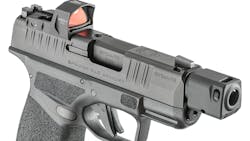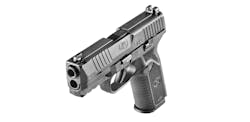For as far back as I can remember, basic marksmanship has been comprised of seven things:
- Stance
- Grip
- Sight alignment
- Sight picture
- Breath control
- Trigger press
- Follow through
A few experienced combatants I know (those folks who have actually fired shots at, and been shot at by, bad guys, have said that stance and breath control were mostly ignored when the lead started flying. Others will add that sight alignment didn’t really happen as we’re taught it as a discipline on the range. Mostly they just pointed the gun at the target (bad guy shooting at them), looked across the top of the gun, saw their front sight, saw the bad guy on the other side of it (a sight picture of sorts), and squeezed the trigger. So of the seven pieces of basic marksmanship, when things went sideways, at least three were completely ignored under threat. That presents a problem and is part of the reason why, in actual shootings, so many only hit about 20% of their shots.
Enter the red dot sight. Using a red dot sight does away with the requirement for sight alignment. There is no rear red dot and front red dot… there’s just the dot. Keep both eyes open, get a sight picture where the dot is in or near the middle of your target and press the trigger properly. At standard handgun engagement distances (25 yards or less), it’s amazingly easy to shoot tight shot groups if you achieve two things: sight picture (dot where you want it on the target) and good trigger squeeze.
Why would that be? Simplicity is the best answer I can come up with. With iron sights you have to achieve, and hold, “equal height, equal light” throughout your trigger press. You have to align your sights, then overlay them on a target and then press the trigger while doing everything you can not to move that gun even the smallest amount. With the red dot sight, you don’t have to achieve equal height, equal light and you don’t have to try to hold it while you press the trigger. You just put the dot where you want it and keep it there while you press the trigger until the weapon fires.
Now you may have noticed that I talk about sight picture and trigger press throughout. Yes, and here’s why. I know a man who regularly qualified 100% with any duty weapon handed him. Then one day he mounted a laser aiming unit on his handgun and all of a sudden his shooting tanked. The reason for that turned out to be that he started ignoring trigger discipline and sight picture maintenance. The “magic red dot” showed where his shot would hit so he jerked the trigger and the red dot did exactly that: it bobbed down and left on the target as the shot was fired and the hole showed up where the red dot was when the shot actually was discharged. Then the man followed up, putting the red dot back on the bullseye. After we figured out what he was doing (it didn’t take much), he felt pretty silly and started paying attention again. Sight picture, trigger press. Back to 100% qualification scores he went.
Finally, for older shooters like myself, getting that front sight in crispy focus can be a challenge. Using a red dot sight alleviates some of that challenge. The dot may not be crispy clear, but it’s also not the focus so it’s not supposed to be. The target is the focus. Real, quick let’s do some comparisons and see why a blurry dot is no big deal.
For the purpose of this discussion, please accept that “combat accuracy” is the ability to hit a pie plate (about an 8-10” circle) on a target at 25 yards. Now recognize that “1 MOA” is 1” at 100 yards, so 1 MOA at 25 yards is only .25”. Many red dot sights have either 3 or 4 MOA dots, so that equates to between .75” and 1” variance at 25 yards. Most of the shooters I know, myself definitely included, aren’t good enough to shoot groups that tight free hand at 25 yards. I’m lucky if I can keep it that tight at 15 yards—but at 7 yards it becomes a lot more possible. Now let’s say, for a moment, that the 3 MOA dot is blurry because you’re focusing properly on the target and not the dot. How blurry is the dot? Is your 3 MOA dot now 4 MOA? 5? 6? Let’s make this as ugly as it can be and say that your 3 MOA dot has doubled in size because it’s blurry and is a 6 MOA dot. Do the math… That’s a 1.5” variance at 25 yards. I still don’t know anyone that good and a 1.5” shot group would be well within the confines of combat accuracy - with six to eight inches of “wiggle room.” That’s why I balk at people who say a 4 MOA dot isn’t accurate enough on their handgun. Um… that’s 1” at 25 yards. I guess if you need to shoot out a hostage taker’s eye at 25 yards, with a handgun… that’s necessary. But to hit an attacking bad guy somewhere in his center chest at 25 yards, the 4 MOA dot is more than sufficient.
For all of the above articulated reasons, the red dot sight is here to stay - and if you’ve been resisting it like I did for years, just stop. Go to the range with a friend who has one or a range that will let you rent one and try it out. Shoot your duty caliber at 5, 7, 10, 15 and 25 yards. Take your time and use the red dot as your only sighting system. Focus on your sight picture and trigger press. Acknowledge when you make a mistake like flinching or jerking the trigger. Don’t mistakenly attribute those displaced shots to the red dot sight. The sight will work fine if you do your job. And if you do your part properly, I think you’ll quickly realize how advantageous the red dot sight can be.
About the Author
Lt. Frank Borelli (ret), Editorial Director
Editorial Director
Lt. Frank Borelli is the Editorial Director for the Officer Media Group. Frank brings 20+ years of writing and editing experience in addition to 40 years of law enforcement operations, administration and training experience to the team.
Frank has had numerous books published which are available on Amazon.com, BarnesAndNoble.com, and other major retail outlets.
If you have any comments or questions, you can contact him via email at [email protected].


